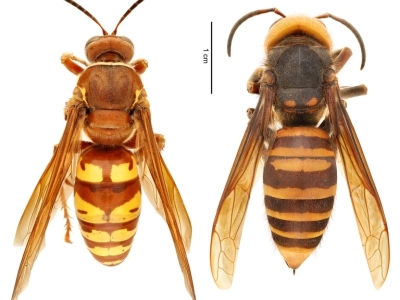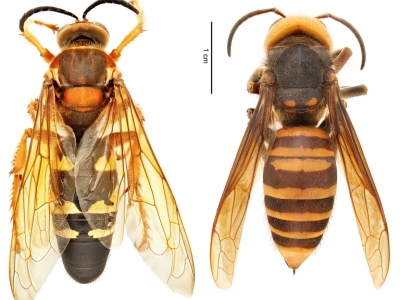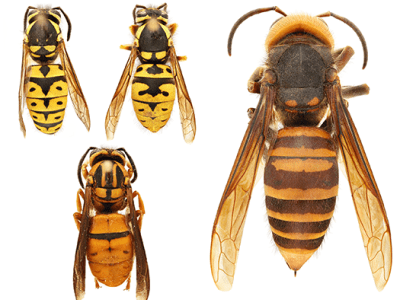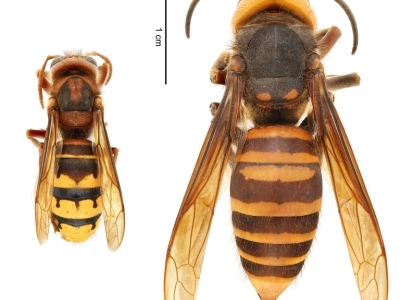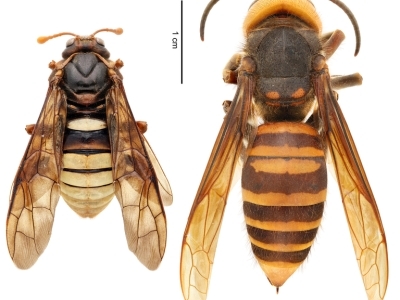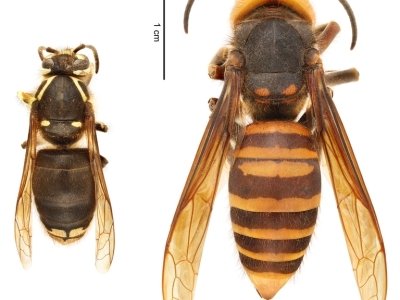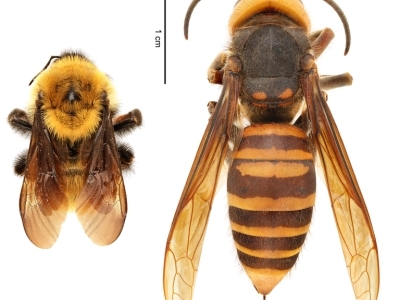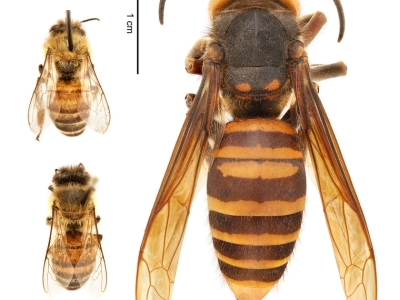Northern Giant Hornet
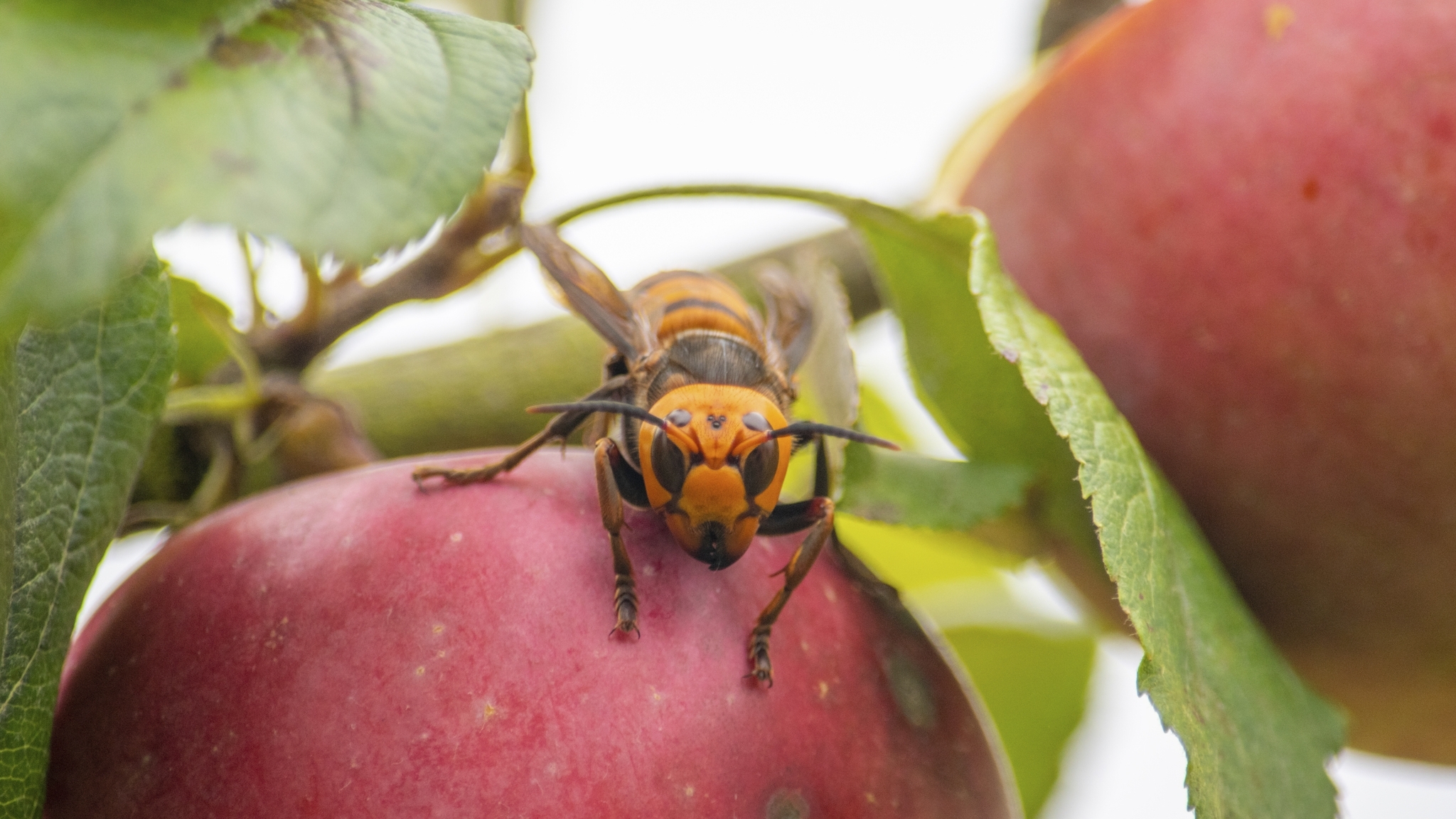
Washington Department of Agriculture
The northern giant hornet (Vespa mandarinia) is the largest hornet in the world, measuring up to 2 inches long. This invasive species, native to Asia, generally doesn't attack people unless it feels threatened. However, it poses a grave threat to honey bee hives, which it can destroy within hours.
The pest preys on honey bees and poses an indirect threat to plants that depend on honey bees for pollination. The northern giant hornet was first reported in the Vancouver Island area of Canada in August 2019 and has since been detected in the northwest corner of Washington State. If it spreads to other U.S. States, it could adversely impact honey bees and the pollination services they provide.
The northern giant hornet has a distinct appearance. Here's what to look for:

Body length
It measures 1.5 to 2 inches.
Coloration
This pest has a large, solid yellow or orange head with black eyes. Its abdomen has alternating bands that appear dark brown or black and yellow or orange. Its thorax is mostly solid dark brown or black, making a striking contrast with the color of its head.
Despite the northern giant hornet's large size and distinguished markings, people often confuse it for these species:
- Western cicada killer (Sphecius grandis)
- Eastern cicada killer (Sphecius speciosus)
- Various species of yellowjackets (Vespula spp.)
- Great golden digger wasp (Sphex ichneumoneus)
- European hornet (Vespa crabro)
- Elm sawfly (Cimbex Americana)
- Various species of paper wasp (Polistes spp.)
- Bald-faced hornet (Dolichovespula maculata)
- Pigeon tremex (Tremex columba)
- Yellow bumblebee (Bombus fervidus)
- European honey bee (Apis mellifera)
View our photo gallery for details on these species and how they compare to the northern giant hornet.











(left) Western cicada killer (Sphecius grandis)
- Found in the Western United States
- Can be up to 2 inches long
- Has a smaller head in proportion to the body than northern giant hornet (right) and different banding on the abdomen
- Has a reddish thorax instead of black, like northern giant hornet (right)
- Note: The contrast between the head color and the thorax color is much more apparent in northern giant hornet (right) than in cicada killers (left).
(left) Eastern cicada killer (Sphecius speciosus)
- Found in the East and Midwest
- Can be up to 2 inches long
- Has a smaller head in proportion to the body than northern giant hornet (right) and different banding on the abdomen
- Has a reddish thorax instead of black, like the northern giant hornet (right)
- Has round eyes, unlike hornets
- Note: The contrast between the head color and the thorax color is much more apparent in northern giant hornet (right) than in cicada killers (left).
(left) Various species of yellowjackets (Vespula spp.)
- Different species found throughout the United States
- Grow to about .5 inches long, significantly smaller than northern giant hornet (right)
- Often are more brightly marked with yellow or orange and black than the northern giant hornet (right)
(left) Great golden digger wasp (Sphex ichneumoneus)
- Found throughout much of North America
- About 1 inch long
- Has a “wasp waist” that is very narrow and long
- Has a dark brown to black body, with orange to yellow legs
- Has an abdomen that is black with solid orange/red toward the front end, with no banding like the northern giant hornet (right)
- Has golden hairs covering the head and middle of the body, making this species distinctive
(left) European hornet (Vespa crabro)
- Found in the Eastern United States, especially in the Southeast
- Not found west of the Rocky Mountains
- Ranges in size from 1 to 1.5 inches long, usually around half the size of a northern giant hornet (right)
- Has markings that can vary, but appears to have “teardrops” of brown to black on the primarily yellow abdomen
- Has a dark band on the abdomen right after the “wasp waist,” unlike the yellow band in the northern giant hornet (right)
(left) Elm sawfly (Cimbex Americana)
- Found throughout much of North America
- Ranges in size from .75 to 1 inch long
- Lacks a “wasp waist” between the thorax and abdomen (unlike the northern giant hornet [right])
- Has a white or yellow spot on the thorax
- Largest sawfly on the continent
- Note: Females may be yellow, resembling a wasp.
(left) Various species of paper wasp (Polistes spp.)
- Found throughout North America
- Can grow to about .75 inches long, significantly smaller than northern giant hornet (right)
- Note: Most paper wasps have a well-defined “wasp waist” that separates them from other hornets.
(left) Bald-faced hornet (Dolichovespula maculata)
- Found throughout much of North America, but most commonly in the Southeastern United States
- Ranges in length from .5 to .75 inches, although they're usually slightly larger than yellowjackets
- Can be identified by their mostly black abdomen with white markings
(left) Pigeon tremex (Tremex columba)
- Distributed widely in eastern North America, ranging as far west as Utah and Arizona
- Can be up to 2 inches long
- Lacks a “wasp waist” between the thorax and abdomen, unlike northern giant hornet (right)
(left) Yellow bumblebee (Bombus fervidus)
- Found throughout much of the Western and Northeastern United States
- Has black coloring with yellow stripes
- Grows to about .5 inches long
- Has a very stout body
- Note: Bumblebees can be separated from wasps and hornets because their bodies are covered in hairs and appear “fuzzy,” and they have a structure for gathering pollen on their hind legs.
(left) European honey bee (Apis mellifera)
- Found in every State
- Grows to about .5 inches long
- Has reddish-brown coloring (this can vary depending on the race)
- Has dark bands on the abdomen, as well as a structure for gathering pollen on their hind legs
Spring: A fertilized queen emerges after surviving the winter. She enters a brief pre-nesting stage. The queen feeds on sap, develops her ovaries, and looks for a suitable nesting site. She usually nests in preexisting underground cavities with a narrow opening, such as rodent burrows.
Summer: Once the queen selects a suitable site, she enters a solitary phase. During this time, she alone is responsible for building a nest, foraging, laying eggs, and caring for young. When around 40 workers are in the nest, the colony enters a new phase. The queen becomes completely nest-bound, and the workers assume all duties outside of the nest.
Late Summer/Early Fall: When there are many workers, the colony begins producing males and the next year’s queens. Workers feed these new “reproductives” within the nest because reproductives do not forage. To obtain food with higher protein, northern giant hornets may attack honey bee hives in the late summer/early fall. The hornets kill all of the adult bees and leave them at the bottom of the hive. Then the hornets remove the hive’s brood, taking bee larvae and pupae back to their nests. Northern giant hornets may attack other social bees and wasps at this time.
Fall: Males develop and leave the nest before females. They will perch at the entrance of nests waiting to mate with the new queens, which emerge about 1 month later. New queens must mate before overwintering because males will not be present when the queens emerge the following spring.
Winter: After mating, a new queen will spend the colder months overwintering in a sheltered spot she has excavated in the soil, rotting wood, or piles of straw. The cycle begins again the following spring when the new queens emerge from overwintering.
Report Plant Pests and Diseases
Have you seen this pest or signs of pest damage? Immediately report your findings. In Washington State only, people should report potential sightings of the northern giant hornet to the Washington State Department of Agriculture.
Find your State plant regulatory official
Find your State plant health director


